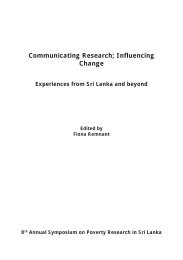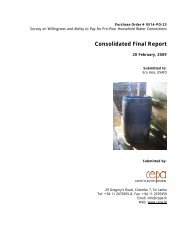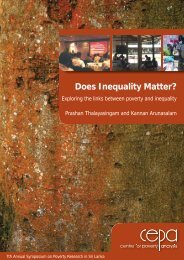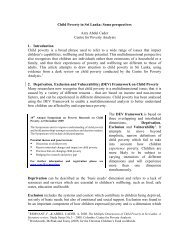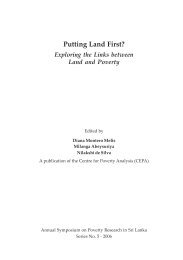Involuntary Displacement and Resettlement â Policy and ... - CEPA
Involuntary Displacement and Resettlement â Policy and ... - CEPA
Involuntary Displacement and Resettlement â Policy and ... - CEPA
- No tags were found...
Create successful ePaper yourself
Turn your PDF publications into a flip-book with our unique Google optimized e-Paper software.
Home-based industriesHome-based livelihood activities were those conducted within the residencesuch as catering, sewing, home gardening <strong>and</strong> livestock rearing. In numbersthe loss of home-based industries is small, unlike commercial or agriculturalproperty losses. These activities were informal <strong>and</strong> at a very micro level butproduced a substantial additional income to the household. Micro activitysuch as wage labour has been the sole income in only about 10% of thepopulation.According to the monitoring findings, the replacement of these activities hasbeen low. Given that it was a secondary income, the priority given to itsreplacement was lower than that of housing replacement, which was vital.These activities were very location specific, <strong>and</strong> relocation depended on l<strong>and</strong>availability. The new l<strong>and</strong> was often not favourable, due to reasons such aslack of space <strong>and</strong> breaking up of market networks.This group was the primary target group assisted by the Income RestorationProgramme. Assistance to households was limited to home gardening <strong>and</strong>enterprise development. However, the IRP concentrated more on householdsthat lost homes <strong>and</strong> property as opposed to households that lost agriculture<strong>and</strong> commercial l<strong>and</strong>, which also had a need for such assistance. The cashcrop survey found that only 19% of the households that lost agricultural l<strong>and</strong>received non-monetary assistance in the interim period.6 Key Factors Linked to the Recovery of LivelihoodsMonitoring the impact of the STDP on these three livelihood areas(aagricultural/commercial/home-based industries), showed that the followingkey factors were linked to the recovery of livelihoods:Low intensity of lossIntensity of loss is a key aspect that determines the recovery of thelivelihoods affected. It is seen in terms of a larger percentage of l<strong>and</strong> lost,particularly in the case of small holdings. Those who lost a larger proportionof their l<strong>and</strong> were identified as having a high intensity of loss.The initial findings of monitoring indicate that those who have lost smallpercentages of l<strong>and</strong> from larger holdings, were better able to recover thanthose who had small holdings <strong>and</strong> lost most of it. This is particularly true withcash crop cultivators, where some households who had large l<strong>and</strong> holdings51



